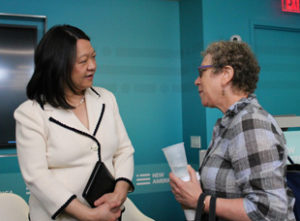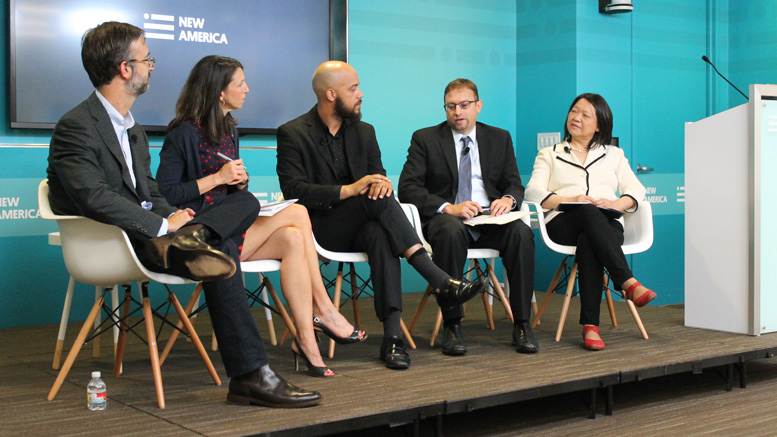Community colleges that serve a largely adult population need to understand that for students 25 and older, “education is not the center of their lives,” according to Pam Eddinger, president of Bunker Hill Community College (BHCC) in Boston.
Their jobs and their families are more important to them, Eddinger said, “we are only part of their lives.”
Eddinger spoke this week at a panel discussion in Washington, D.C., on how higher education can better serve adult students. It was presented by New America and Washington Monthly.
Most institutions of higher education – other than community colleges – haven’t adapted to the new reality that there’s a growing number of students age 25 and older, said Paul Glastris, editor in chief of Washington Monthly.
Colleges must do a better job of serving adults if Lumina Foundation is to meet its completion goal of 60 percent of Americans earning a postsecondary degree by 2025, said Courtney Brown, vice president of strategic impact at Lumina.
To meet that goal, 71 percent of that target group are adults returning to college or who have never enrolled in higher education, Brown said.
Adults have other needs
At BHCC, only a third of the students are recent high school graduates, Eddinger said. The typical student is 27 years old.
Three-quarters of Bunker Hill students work, many of them full time. Three out of five students are parents, and 77 percent of students are in the two lowest quintiles of income, Eddinger said.
“Yet they all know that what’s going to move them forward is education,” she said. They have the expectation that after they graduate their incomes will rise and their lives will be transformed.
Nationally, the average age of community college students is 28, according to the American Association of Community Colleges. Nearly 40 percent of all public two-year college students are 22 to 39 years old. Another 10 percent are over 40.
Other factors: More than one-third are the first in their families to attend college, and 17 percent are single parents. Twenty-two percent go to college full time and work full time; Another 40 percent attend full time and work part time. Forty-one percent are part-time students with full-time jobs.
More concentrated work
Monroe Community College in Rochester, N.Y., meets the needs of adult students by having more intensive, accelerated programs that enable students to complete college faster, said Todd Oldham, the college’s vice president of economic development and innovative workforce services.
In one example, a program to train medical assistants schedules classes in the morning, so students who are parents can pick up their children after school.
By matching salaries earned by Monroe graduates to labor market outcomes, the college demonstrates the value of higher education credentials, Oldham said. That helps people trapped in generational poverty understand the importance of education and it also shows funders the value of investing in the college.
Community colleges might be open access, but they still need to address transportation and childcare to ensure they are really accessible to those most in need, Oldham said.
Scorecards not effective
The forum was held in conjunction with the release of Washington Monthly’s 2017 college rankings, which this year highlights colleges that best serve adult learners.
AACC doesn’t support ranking colleges, as its members are open-access institutions and serve different types of communities with different services.
Eddinger said she has trouble with “the concept of simple scorecards” that tell you nothing about how well colleges actually serve students. Instead of complaining about low graduation rates, the “larger conversation should be about how to solve the problem. Just judging doesn’t help us.”

Bunker Hill Community College President Pam Eddinger (left) speaks with a member of the audience.
Even if tuition and fees are covered by student aid, “that’s not the total cost of education,” Eddinger added. Students still have to cover housing, transportation and food costs, and if they are spending 25 hours a week in class, that’s time when they can’t work.
Forty-five percent of the students at BHCC are food insecure, and 14 percent are homeless, she noted. That means they have to choose whether to pay rent or a utility bill or buy food. “The magic is they’re choosing to come to class.”
Bunker Hill tries to meet those needs by having an emergency office where students can make sandwiches for their families and provides information about community resources.
“We worry about graduation and completion rates,” Eddinger said, but college presidents should also provide a leadership role in advising students where they can get help with housing, food and transportation.
What’s ultimately needed to ensure these efforts are sustainable are policies on urban and rural poverty, she said. What will really help poor students succeed in community college are free lunch programs, for example.
“It’s about how the conversation is conducted,” Eddinger said. Poor people don’t want to be “saved,” she said. “They have things to offer. We need to talk about cultural wealth and family networks, not poverty or social deficits.”
Empowering students
John Locke, who enrolled in the University of Houston-Downtown as an adult, said he thrived there because the climate empowers students to implement their ideas, the smaller classes make it easier to build relationships with professors, and “administrators and leaders are accessible to students in a real way.”
“Adult learners who just go to class and go home are not taking part in the whole college experience,” Locke said. Getting involved in extracurricular activities and campus organizations “helps you get a real feel about what you want to do; helps you connect what you’re learning in class to the real world.” Students at his college, for example, took the initiative to establish a daycare center on campus, although it took four or five years.
Locke had dropped out of school in the 10th grade, “hung around with the wrong people” and lived in a shelter before he enrolled in college. “The experience of being welcomed at college was transformative for me,” he said.
He was elected student body president and formed an organization called Walk 2 Vote, which encourages students who have never voted before to become engaged in the process by going to the polls in a group and viewing voting as a celebration, not just a civic duty.

